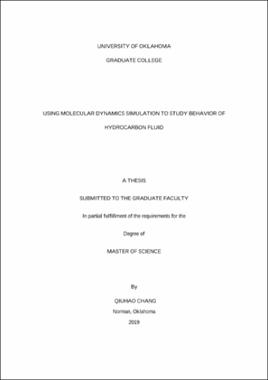| dc.description.abstract | The purpose of this thesis is to study hydrocarbon fluid behavior with molecular dynamics (MD) simulations. In the past two decades, MD simulation has been proved to be a reliable tool in the study of oil and natural gas properties, and it plays an essential role to seek fundamental understandings from the molecular level.
For shale gas reservoirs, the storage of adsorbed gas is a large portion of original gas in place (OGIP). At first, the combination of MD simulation and cylindrical simplified local density (SLD) model was used to study the adsorption of hydrocarbon fluid in cylindrical nanopores through the analysis of local density distribution profiles. The second MD study in this thesis is about the phase behavior of petroleum fluids. To both convention and unconventional reservoirs, the ability to predict the state (gas or liquid) of a component is critical in many petroleum processes. In this thesis, with the trajectory from MD simulations, three different post-analysis methods have been evaluated to identify the phase of hydrocarbon fluid under a specified condition. Lastly, MD simulations have been performed to investigate the behavior of CO2 from water/oil/CO2 mixtures. Those systems are important to the tertiary recovery of conventional oil reservoirs. The industry has been developing technologies such as immiscible CO2 flooding and in-situ CO2 generation method. However, a systematic and molecular-level understanding of the phase behavior of the water/oil/CO2 systems is still incomplete.
The completed studies in this thesis include: (1). The adsorption behavior of hydrocarbon fluid in cylindrical nanopore was studied by using both the MD simulation and SLD model. In addition, the competitive adsorption between methane and n-butane molecule in nanopores was investigated by both methods. Lastly, a new method which combines SLD model and pore size distribution has been developed to estimate the OGIP of shale gas reservoirs. (2). Three post-analysis methods that utilize MD simulation trajectories have been evaluated to identify the phase state of methane and n-butane under a certain temperature and pressure condition. Although future efforts are needed to improve the accuracy, the completed work and the general ideas proposed in this study are important references to future studies in this field. (3). In the water/oil/CO2 mixtures, the effect of pressure and temperature on CO2 self-diffusion was studied via MD simulations. Additionally, a constructive idea by using MD simulations to determine CO2 partition coefficient of water/oil/CO2 systems was proposed. | en_US |
